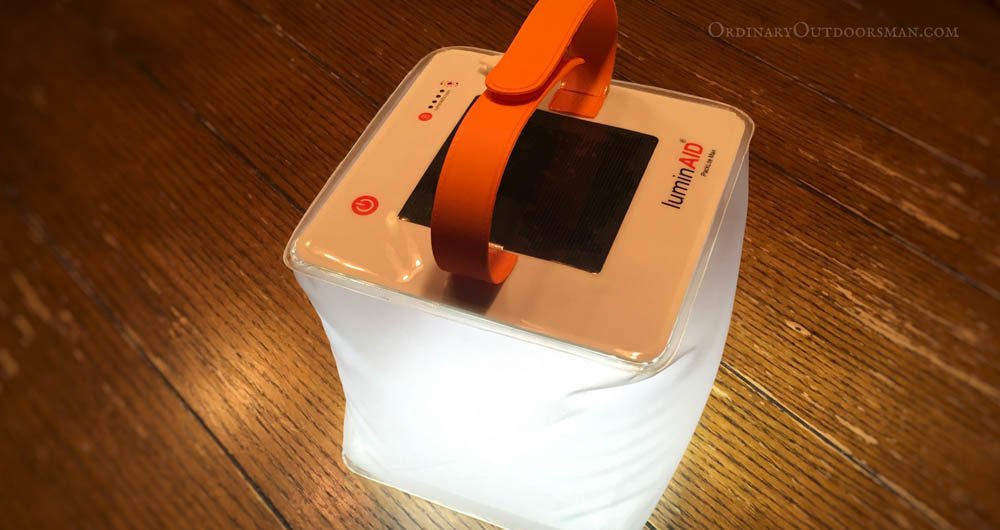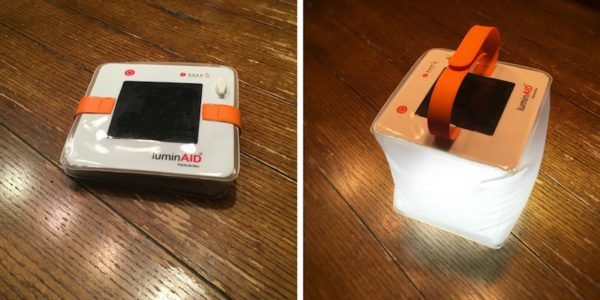I generally hate lanterns. They can be so fussy. You have to have the right fuel, extra mantles, and you often get the fuel on your hands in the process of getting one going. Propane lanterns are easier to use, but sill a pain as they get hot and can make a lot of noise, and all traditional lanterns bring with them the dangers associated with carrying around a small, brightly burning flame.
Battery powered lanterns are a step up…except when you forget to check the batteries or pack extras.
So I was intrigued when I started seeing solar powered lanterns. Yes, they still use batteries to store power, but with the ability to easily recharge them each day.
Some of the links in this post are “affiliate links.” This means if you click on the link and purchase the item, Ordinary Outdoorsman will receive an affiliate commission.
I purchased the luminAID PackLite Max USB Solar Inflatable Lantern (buy on Amazon.com) and I am very impressed. Priced around $30, it’s a little more than other battery powered lanterns, but about the same price or cheaper than traditional combustion lanterns. LuminAID also sells a similar, smaller model with less brightness and battery life (luminAID PackLite Nova). The reason I chose this model is because it can be charged using the built-in solar panel or using a standard USB charger like the one we all have for our phone.
Review of the luminAID PackLite Max USB Solar Inflatable Lantern
Positives of the luminAID PackLite Max:
Compact and lightweight. Because this lantern is inflatable, it is light and can be stored in it’s compact state without requiring much space.
Waterproof up to one meter. It is essentially like one of those inflatable water toys your kids have. It’s a plastic bubble with the electronic components sealed inside. As long as it isn’t damaged, you don’t have to worry about it getting wet in a rain shower. Just be sure the USB charging port is sealed. And obviously when it is inflated it would also float…if you happened to drop it in the lake for some reason.
No need to mess with batteries. With either USB or solar charging capabilities, you don’t have to worry about bringing extra batteries. Headed out camping? Throw it on the dashboard or plug it in to your phone charger on your way to your destination. It only takes 1-2 hours to charge via USB. Having a USB charging jack also means that most standard phone charging accessories will work with the luminAID including those external battery packs.
Long battery life. The luminAID boasts that on a full charge and on the lowest light setting (it has 4) it can last up to 50 hours.
No fuel to mess with. No concerns about fire. Perfect for use in the tent where a lantern is not advised.
Negatives of the luminAID PackLite Max:
USB charging. The “with USB” is a bit confusing and has obviously been misunderstood by many. When I saw the lantern and read the product description, I mistakenly believed that the lantern could also be used to charge USB devices (like a phone). However, the “USB charging” feature is strictly an alternative method for charging the batteries when the sun isn’t available or time does not allow for solar charging. (Note: luminAID has a model in development that can be used to charge other devices. It looks to be available soon.)
Lower light output. The reality is that traditional combustion lanterns can put out more light. If you expect the same degree of brightness from the luminAID you’ll be disappointed. However, at 150 lumens, it is more than enough for most situations and comparable to other battery powered LED lanterns.
That’s it. I don’t have any other complaints about this product. I wonder how it will hold up over time, but that’s it.
Best uses for the luminAID PackLite Max:
Backcountry hiking & camping. The lantern is lightweight, collapsable, and waterproof. You can strap this lantern to your pack to charge during the day without any concerns. It’s also lightweight enough that it won’t weigh you down on a backcountry trip.
General camping. I take the luminAID on all my camping trips. It’s a fantastic general purpose lantern, especially for use inside a tent where you wouldn’t normally want to take a combustion lantern.
Emergency use at home. The luminAID boasts the ability to hold a charge for up to 2 years in storage. You can charge the lantern and stick it in a drawer just like you would a standard flashlight for use when the power goes out for some reason. Better yet, keep it somewhere where it can get a little sun and it should be ready for use at any moment.





